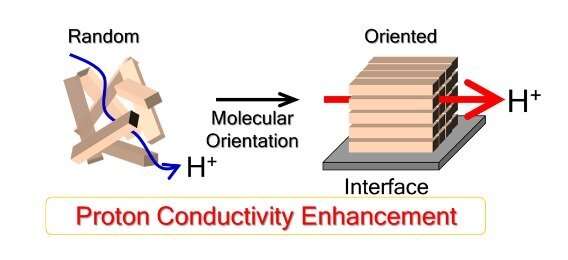According to foreign media reports, recently, a review published in the "Science and Technology of Advanced Materials" magazine said that making hydrogen fuel cell membrane molecules more structural can improve their efficiency, and Hydrogen fuel cells can provide energy for electric vehicles and other industrial applications.

(Source: Japan Institute of Advanced Science and Technology)
Hydrogen fuel cells are components of electric vehicles that produce energy. In order to function, hydrogen fuel cells need to be able to split hydrogen molecules into positively charged protons and negatively charged electrons, and a special type of membrane-proton conducting polymers The membrane has this function. The membrane only allows protons to pass, and the electrons will generate the required current around the thin film, and then transport the protons into the electrochemical catalyst through a thin "ionomer" membrane. In the electrochemical catalyst, electrons and protons will Rejoin.
Studies have shown that transporting protons in thicker proton conducting polymer membranes is better than in thinner ionomer membranes.
Japan Advanced Institute of Science and Technology (Japan Advanced Institute of Science and Technology) materials scientist Yuki Nagao said that the second part of proton transmission must be studied to improve fuel cell performance, so he has been studying proton conductive membranes for many years. Professor Yuki Nagao has adopted the most advanced technology and has been studying the molecular structure of ionomer membranes, and found that the better the internal structure, the better the proton conduction.
Some ion membranes commonly used in hydrogen fuel cells are made of perfluorosulfonic acid. Such membranes can be placed on surfaces made of silicon oxide, magnesium oxide, or sprayed platinum or gold. Nagao found that the proton conductivity in such a film depends on the type of surface and may affect the performance of the fuel cell.
In another film made of alkyl sulfonated polyimide, its molecules will become more structural as the water absorption increases. This feature is that when a solvent is added, the material can enter the liquid crystal. Phase caused.
Now, further research is still needed to understand how to control the molecular structure by applying an external magnetic field, using its liquid crystal properties, or by establishing a hydrogen bonding network between polymer chains in the film, which will help R & D to use high protons. Various applications of conductive polymer membranes. (Yu Qiuyun)
China Compression Springs Stainless Steel Compression Spring
Compression Springs,Heavy Duty Compression Springs,Stainless Steel Compression Springs,Metal Springs Compression
applicaiton: viation,automotive, motorbike, bicycle, automatic equipment, household appliance, medical device ,toy, telecommunication,computer, instrument and meter,furniture, electric tools,mold and other industries
China leading manufacturers and suppliers of Compression Springs,coil spring,compress spring coil,Heavy Duty Compression Sprins,Stainless Steel Compression Spring,Metal Compression Spring, etc.
coil spring,compress spring coil,Heavy Duty Compression Sprins,Stainless Steel Compression Spring,Metal Compression Spring
Shenzhen Lanejoy Technology Co.,LTD , https://www.grill-mesh.com